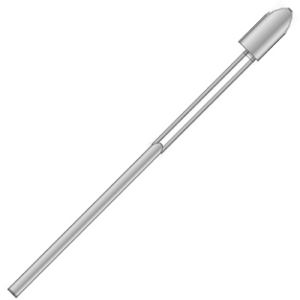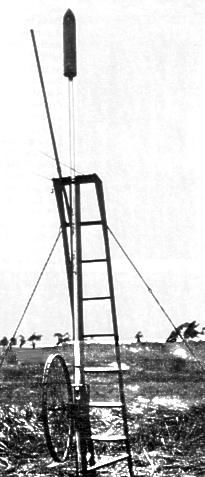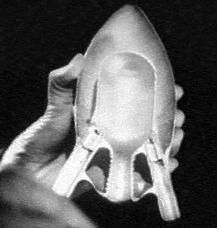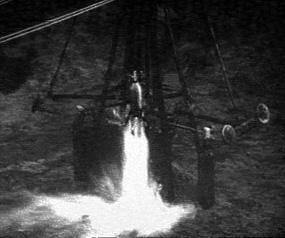
Home - Search - Browse - Alphabetic Index: 0- 1- 2- 3- 4- 5- 6- 7- 8- 9
A- B- C- D- E- F- G- H- I- J- K- L- M- N- O- P- Q- R- S- T- U- V- W- X- Y- Z
Mirak
 Mirak Credit: © Mark Wade |
Status: Retired 1932. First Launch: 1931-05-10. Last Launch: 1932-08-01. Number: 7 . Thrust: 588 N (132 lbf). Gross mass: 20 kg (44 lb). Height: 3.50 m (11.40 ft). Diameter: 0.10 m (0.32 ft). Span: 0.10 m (0.32 ft).
In December 1929, after the failure of Oberth to produce a liquid propellant rocket for Fritz Lang, the VfR was in shambles. Winkler had resigned as president. A meeting was held, with Nebel, Wurm, Oberth, Klaus Riedel, Winkler, and Willy Ley in attendance. It was decided to try and get the Oberth rocket materials back from Ufa and press on to demonstrate flight of a liquid propellant rocket. For this purpose the Oberth rocket was much too ambitious and probably wouldn't work anyway. Nebel proposed building a new 'Minimum Rakete' or 'Mirak' to demonstrate that it could be done. The group obtained funding from two private benefactors and began to ground test and perfect Oberth's 'Kegelduese' conical rocket motor in the summer of 1930. By July of that year the Kegelduese is being run for 90 seconds, generating 7 kgf and consuming 6 kg of liquid oxygen and 1 kg of gasoline in that time (specific impulse 90 seconds). A month later Nebel and Riedel begin a series of tests of the Mirak rocket at the farm of Riedel's grandparents near Bernstadt, Saxony. They slowly perfect the motor, finally achieving significant net thrust by September, when the motor explodes, ending the test series.
Nebel and the other designers realize that using liquid oxygen to cool the combustion chamber simply would not work - it turned to gas, and the excessive pressure eventually burst the oxygen tank. They turn to a water-cooled combustion chamber. The end result was an aluminum pressure-fed engine that weighed 85 g but produced 32 kgf while burning 160 g of liquid oxygen and gasoline per second - a specific impulse of 200 seconds. The new design proves reliable and is demonstrated to visitors from the American Rocket Society in April 1931.
In May 1931 Riedel improvised a rocket, using the thrust chamber developed for the Mirak, fed by two long tanks containing liquid oxygen and gasoline, which would form guiding sticks for the forward-mounted engine. The lashed-together rocket rises to 20 m on its first 'static' test. On 14 May a flight-weight version of Riedel's 'flying test stand' takes off into a looping trajectory, sending the VfR experimenters running for cover, but reaching 60 m altitude in the process. Further launches through that summer of the Mirak II reach altitudes of over a kilometer, and demonstrate recovery by parachute and reuse of the rocket. 87 test flights are conducted that summer.
The Mirak III debuted the following summer. The rocket was 3.5 m long and 10 cm in diameter, had a gross lift-off mass of 20 kg, an empty mass of 10 kg, and a thrust of 60 kgf. The new design featured the engine forward of the stack, followed by the liquid oxygen tank, then the alcohol tank, then the manometers and other elements of propellant pressurization. The new-design engine was developed by Walter Riedel and Arthur Rudolph at the Heylandt Company. The rocket reached an altitude of 20 to 70 m before veering horizontally into a forest. An exhaust velocity of 2000 m/s was expected, but only 1700 m/s was demonstrated.
As the influence of Nazism in German Society increases, the VfR disintegrated in political disputes and withdrawal of funding by its wealthiest backers. German rocket development was taken over by the Army, and the remaining private experimenters - Nebel, Winkler, and Puellenberg - were ordered by the Gestapo to cease and desist.
People: Nebel. Country: Germany. Launch Sites: Raketenflugplatz, Kummersdorf. Bibliography: 17, 394, 47, 693.
 | Mirak 2 Credit: © Mark Wade |
 | Mirak Credit: © Mark Wade |
 | Mirak |
 | ORM at Kummersdorf |
 | ORM at Kummersdorf |
December 1929 - . LV Family: V-2. Launch Vehicle: Mirak.
- VfR regroups - .
Nation: Germany.
Related Persons: Ley,
Nebel,
Oberth,
Riedel, Klaus,
Winkler.
Winkler had resigned as president. Oberth is back in Berlin, and a meeting is held, with Nebel, Wurm, Oberth, Klaus Riedel, Winkler, and Willy Ley in attendance. It was decided to try and get the Oberth rocket materials back from Ufa and press on to demonstrate flight of a liquid propellant rocket. For this purpose the Oberth rocket was much too ambitious and probably wouldn't work anyway. Nebel proposes building a new 'Minimum Rakete' or 'Mirak' to demonstrate that it could be done. Work begins to obtain funds to ground test and perfect Oberth's 'Kegelduese' conical rocket motor.
1930 April 11 - . LV Family: V-2. Launch Vehicle: Mirak.
- VfR evening in Berlin - . Nation: Germany. Related Persons: Oberth, Winkler. The VfR presents itself to the scientific community in Berlin. Winkler gives a lecture at the auditorium of the Central Post Office, and the Oberth rocket, Kegelduese, and other articles are displayed..
1930 July 23 - . LV Family: V-2. Launch Vehicle: Mirak.
- VfR demonstrates rocket motor to German government officials - .
Nation: Germany.
Related Persons: Ley,
Nebel,
Oberth,
Riedel, Klaus,
von Braun.
The VfR fires its 'Kegelduese' liquid oxygen and gasoline-fueled rocket motor in a demonstration for the Director of the Chemisch-Technische Reichsanstalt in an attempt to secure financial support. Nebel had arranged the demonstration and runs the Kegelduese for 90 seconds. It generates 7 kgf and consumes 6 kg of liquid oxygen and 1 kg of gasoline in that time (specific impulse 90 seconds). Participating are Oberth, Nebel, Riedel, Ley, and Von Braun. Nebel's Mirak is not yet ready to test.
August 1930 - . LV Family: V-2. Launch Vehicle: Mirak.
- Mirak experiments - .
Nation: Germany.
Related Persons: Nebel,
Riedel, Klaus.
Nebel and Riedel conduct a series of tests of the Mirak rocket at the farm of Riedel's grandparents near Bernstadt, Saxony. They slowly perfect the motor, finally achieving significant net thrust by September, when the motor explodes, ending the test series.
1930 September 27 - . Launch Site: Raketenflugplatz. Launch Complex: Raketenflugplatz. LV Family: V-2. Launch Vehicle: Mirak.
- Raketenflugplatz Berlin - . Nation: Germany. Related Persons: Nebel. Nebel signs the $4/year lease for the worlds first 'Rocket Port', an abandoned German army munitions storage area on 10 square kilometres on Tegeler Weg in the Berlin northern suburb of Reinickendorf. The numerous bunkers are ideal for rocket motor tests..
Spring 1931 - . Launch Site: Raketenflugplatz. Launch Complex: Raketenflugplatz. LV Family: V-2. Launch Vehicle: Mirak.
- Second Mirak explodes - .
Nation: Germany.
Related Persons: Nebel.
Nebel and the other designers realise that using liquid oxygen to cool the combustion chamber simply would not work - it turned to gas, and the excessive pressure eventually burst the oxygen tank. They turn to a water-cooled combustion chamber. The end result was an aluminium pressure-fed engine that weighed 85 g but produced 32 kgf while burning 160 g of liquid oxygen and gasoline per second - a specific impulse of 200 seconds. The new design proves reliable and is demonstrated to visitors from the American Rocket Society in April 1931.
1931 May 10 - . Launch Site: Raketenflugplatz. LV Family: V-2. Launch Vehicle: Mirak.
- Mirak II / Repulsor - .
Nation: Germany.
Related Persons: Riedel, Klaus.
Apogee: 0.0020 km (0.0012 mi).
Riedel improvises a rocket, using the thrust chamber developed for the Mirak, fed by two long tanks containing liquid oxygen and gasoline, which would form guiding sticks for the forward-mounted engine. The lashed-together rocket rises to 20 m on its first 'static' test.
1931 May 14 - . Launch Site: Raketenflugplatz. LV Family: V-2. Launch Vehicle: Mirak.
- Mirak II / Repulsor I rocket reaches 60 m. - .
Nation: Germany.
Apogee: 0.0060 km (0.0037 mi).
First official test flight of the Mirak (Minimum Rakete) II. A flight-weight version of Riedel's 'flying test stand' takes off into a looping trajectory, sending the VfR experimenters running for cover, but reaching 60 m altitude in the process. Attending were Wernher Von Braun, Klaus Riedel und Kurt Heinisch (Rudolf Nebel, the chief engineer, was in Kiel at the time).
1931 May 23 - . Launch Site: Raketenflugplatz. LV Family: V-2. Launch Vehicle: Mirak.
- Mirak II / Repulsor 2 - . Nation: Germany. Related Persons: Riedel, Klaus. Apogee: 0.0060 km (0.0037 mi). Range: 0.60 km (0.37 mi). The rocket reaches 60 m before heading off horizontally over the Raketenflugplatz, ending up in a tree outside the perimeter, 600 m from the launch point..
Early June 1931 - . Launch Site: Raketenflugplatz. LV Family: V-2. Launch Vehicle: Mirak.
- Mirak II / Repulsor 3 - . Nation: Germany. Related Persons: Riedel, Klaus. Apogee: 0.18 km (0.11 mi). Range: 0.60 km (0.37 mi). This is the first Repulsor equipped with a recovery parachute. It reaches 180 m, but then the parachute deploys early, and it falls into the same clump of trees as Repulsor 2, 600 m from the launch point..
July 1931 - . Launch Site: Raketenflugplatz. LV Family: V-2. Launch Vehicle: Mirak.
- Mirak II rocket reaches height of 500 m - . Nation: Germany. Apogee: 0.50 km (0.31 mi). VfR successfully fired an improved Mirak (Minimum Rakete) II rocket to height of 500 m..
August 1931 - . Launch Site: Raketenflugplatz. LV Family: V-2. Launch Vehicle: Mirak.
- Mirak II / Repulsor 4 - .
Nation: Germany.
Related Persons: Riedel, Klaus.
Apogee: 1.00 km (0.60 mi).
The perfected Repulsor has the propellant tanks close together at the centreline, to form a guide stick in the manner of Congreve's war rockets. It reaches an altitude of 1000 m, and the parachute recovery system functioned perfectly at apogee. Subsequent such 'one stick' Repulsors' will reach 1500 m altitude and 3000 m range - in fact, they are normally launched only partially-fuelled to prevent them landing outside the perimeter of the Raketenflugplatz.
October 1931 - . Launch Site: Raketenflugplatz. Launch Complex: Raketenflugplatz. LV Family: V-2. Launch Vehicle: Mirak.
- Raketenflugplatz featured in newsreel - .
Nation: Germany.
Apogee: 1.50 km (0.90 mi). Range: 3.00 km (1.80 mi).
After one year of operation of the worlds first 'rocket port', the Ufa weekly newsreel carries an extensive film report on the VfR's experiments. By then 270 engine test runs had been completed, as well as 87 test flights of Repulsors. However the filmmakers also capture an errant rocket leaking gasoline onto a shack owned by the police, which burns down. This leads to further restrictions on VfR activities at the site.
March 1932 - . LV Family: V-2. Launch Vehicle: Mirak.
- Mirak III rocket completed. - . Nation: Germany. Apogee: 4.00 km (2.40 mi). It would reach an altitude of 4000 m in subsequent tests..
August 1932 - . Launch Site: Kummersdorf. LV Family: V-2. Launch Vehicle: Mirak.
- Nebel demonstrates VfR liquid rocket to the German Army. - .
Nation: Germany.
Apogee: 0.0700 km (0.0435 mi).
Nebel contacted the German Army and proposed the use of liquid fuel rockets as war missiles. He arranged for Army representatives to observe a demonstration launch at Kummersdorf. Riedel and Von Braun prepare the rocket, which was 3.5 m long and 10 cm in diameter, had a gross lift-off mass of 20 kg, an empty mass of 10 kg, and a thrust of 60 kgf. The new design featured the engine forward of the stack, followed by the liquid oxygen tank, then the alcohol tank, then the manometers and other elements of propellant pressurisation. The new-design engine was developed by Walter Riedel and Arthur Rudolph at the Heylandt Company. The rocket reached an altitude of 20 to 70 m before veering horizontally into a forest. An exhaust velocity of 2000 m/s was expected, but only 1700 m/s was demonstrated.. The Army is seemingly unimpressed. However a month later they hire Von Braun, who drops out of sight.
Fall 1932 - . LV Family: V-2. Launch Vehicle: Mirak.
- Private rocket development in Germany winds down - .
Nation: Germany.
Related Persons: Riedel, Klaus.
As the influence of Nazism in German Society increases, the VfR disintegrates in political disputes and withdrawal of funding by its wealthiest backers. In this period it occurs to Riedel that alcohol may prove a better fuel than gasoline - primarily because as a fuel it needs much less of the expensive and difficult-to-handle cryogenic liquid oxygen. Experiments determine that 60% alcohol to water is the best fuel mixture, and for the first time use the fuel to cool the combustion chamber before leading it into the chamber - regenerative cooling.
Back to top of page
Home - Search - Browse - Alphabetic Index: 0- 1- 2- 3- 4- 5- 6- 7- 8- 9
A- B- C- D- E- F- G- H- I- J- K- L- M- N- O- P- Q- R- S- T- U- V- W- X- Y- Z
© 1997-2019 Mark Wade - Contact
© / Conditions for Use